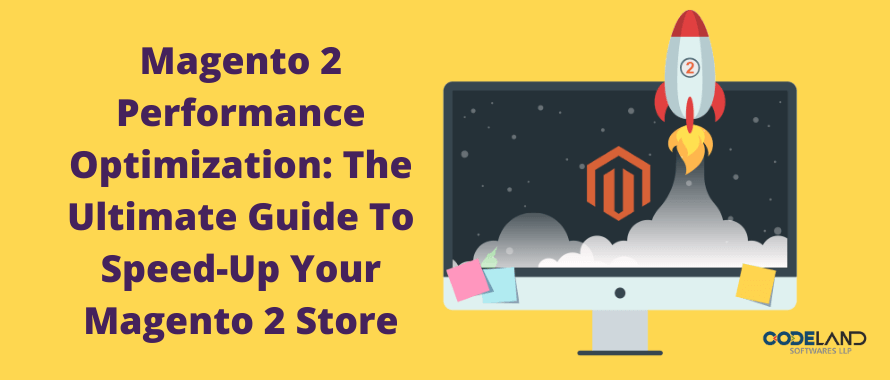Magento 2 Performance Optimization: The Ultimate Guide To Speed-Up Your Magento 2 Store
codeland
October 16, 2020

Magento 2 is probably the most extensive revolution that the eCommerce platforms have experienced over the past couple of months. The decision of store owners to upgrade their existing online stores to the king of the eCommerce platform that Magento 2 is has come out with flying colors and has provided them with the best ROI or almost to meet their expectations. The Magento 2 performance optimization remains a matter of significant concern, and this is something that store owners are looking forward to speeding up their Magento 2 store. Most importantly, if someone wants to experience a seamless service from their online stores, they should focus on optimizing the platform’s performance.Who doesn’t love an online store that is fast, reliable, and becomes more user-friendly for the customers visiting it? Thus, we have decided to prepare an ultimate guideline that highlights all the essential factors related to Magento 2 performance optimization. However, as starters and according to the test benchmarks, it is a proven fact that Magento Enterprise Edition 2.0 simply outperforms the version 1.14.2. Therefore, if your store is still running the existing version of Magento, then probably you now know what the drill is. Now that you know that Magento 2 is a more powerful version that your store should run, you should also be aware of the various additional tech tools that can optimize your store’s performance. Hence, let us begin with our ultimate guideline for Magento 2 Performance optimization without any further ado.
Magento 2 Performance Optimization Pro Tips
For an eCommerce website, it hardly takes less than five seconds to load a particular requested page. Even if it gets longer than usual, it doesn’t feel very pleasant for your prospective buyers. As a result, it starts responding slowly to inputs and eventually loads product pages much slower. On the other hand, the customer will find the same very irritating and head to search for any other place. To optimize your Magento 2 store’s performance and improve the speed, you need to do certain things in the right away. So for the ones who are in a rush, here is the list of things you can do to optimize your Magento 2 store’s performance. Steps for Magento 2 Performance Optimization:- Enabling Flat Categories for Products
- Merging of JS and CSS Files
- Building a Strong Content Delivery Network
- Enhancing the way your site stores Cached data
- Optimizing Product Images
- Enabling the Right Compression
- Reducing Response Time from the Server
- Updating Magento Regularly
| You may also like to read;10+ Actionable Tactics and Lead Generation Strategies for Your Magento Store in 2021 |
Advanced Performance Optimization Guidelines for Magento 2
Now that you know the essential criteria for Magento 2 performance optimization, here are some advanced optimization guidelines for the nerdiest store owners who are reading this.Optimizing Time to First Byte
Time to first byte (TTFB), also known as the server response time, is the first thing you should do to enhance your Magento store’s performance. It is fundamentally the time taken by a browser to request a particular page from the server and the server’s response in generating the HTML, including the latency involved. According to Google’s recommendations, it is ideal to have the TTFB approximately around 200milliseconds. Additionally, if your site is managed by a professional, they can even do some tweaks in your store’s codebase to provide you a boost in the performance.Configuring the Magento Server
Enhancing your Magento 2 store’s performance also means to tweak a few server settings on which the store is running. It includes choosing the right web hosting service provider and utilizing server software. However, the fundamental performance factor for your Magento 2 starts from scratch itself and especially gets better when you decide:- To not go with any cheap hardware options as it will become the root of your store.
- Securing the most number of resources according to your requirements, and that fits your budget.
Minimizing Latency
Hosting your Magento store website depending on your local audience and at a place where it receives the most number of visitors is the primary step to minimizing your store’s latency. To make this thing clear for you, let us state an example. Let’s say you sell designer clothes in Houston, Texas, whereas you have signed up for a hosting service provider in India. Generally, your store is going to suffer latency issues in fetching a faster HTML for a customer in the US. Thus, a proven strategy to combat the same problem is to have your store on a local web hosting service provider. It is also a crucial tactic for Magento 2 performance optimization.Hardware Performance Issues
You can always hire Magento developers on flexible engagement modes to tweak the software side of your store. However, from your side, you should always ensure that the hardware on which your store relies on is the most efficient one. Few things you should discuss with your hosting service provider before signing up are:- Disabling MySQL query cache. As modern servers on MySQL have query cache disabled by default, you should enable it. This becomes the most primary thing when it comes to performance optimization for your Magento store.
- Ensure that the hosting service provider incorporates Solid State Drives (SSDs) on their servers. As a result, it will provide your store with faster load times.
- Ensure that sufficient RAM is available. Or else, once your site runs short of RAM, it starts caching data on the disc resulting in slower response time from the server.
Optimizing CSS Delivery
If you hire Magento developers, then probably CSS will be one of the most important things that you should consider. It is a language that determines the appearance of the website. When the customer reaches your store and selects a particular product, then they are redirected to the next page while all they get to see is a white blank screen. The time the browser takes is because it is loading the CSS of the site during that time. Thus, if you are looking to achieve great load times for your online store, optimizing the CSS would be the foremost thing that you should do.Magento 2 Import-Export Extensions
You can quickly enhance the performance of your store with improved import expert Magento 2 extensions. They are fundamentally PHP code blocks that have functions assigned to improve the performance of your website. They are unquestionably useful and will come in handy while you are trying to optimize your Magento 2 store performance.Final Words
Well, these are some of the key points that you can take into consideration for Magento 2 performance optimization and speed-up your Magento 2 store. However, suppose you want to focus on your core business activities. In that case, it is always advisable to hire dedicated Magento 2 developers to run your store at peak efficiency at all times.Recent Posts
- eCommerce Trends for 2020
- 10 Reasons Why WordPress is The Best CMS
- Artificial Intelligence in Magento 2: Creating New Possibilities for Magento eCommerce Stores!
- Magento 2 Product Types: Here’s Everything You Need to Know About! (Explained with Examples)
- A Comprehensive Guideline: How to Hire Magento Developer in 2021
- 12th Floor, 1215, Ganesh Glory Jagatpur Road, Sarkhej - Gandhinagar Hwy, Ahmedabad, Gujarat. -382481
- info@codelandinfosoft.com
- +91-(971) 411-1577
Copyright © 2021 CodeLand Softwares LLP – All Rights Reserved



